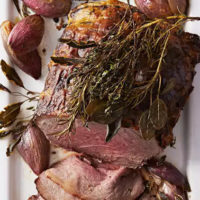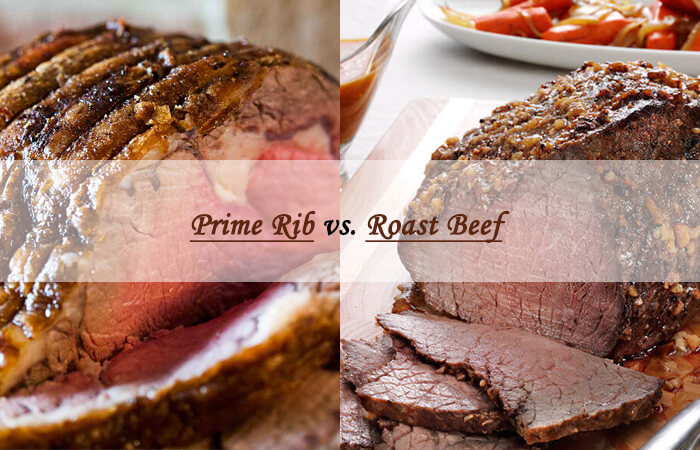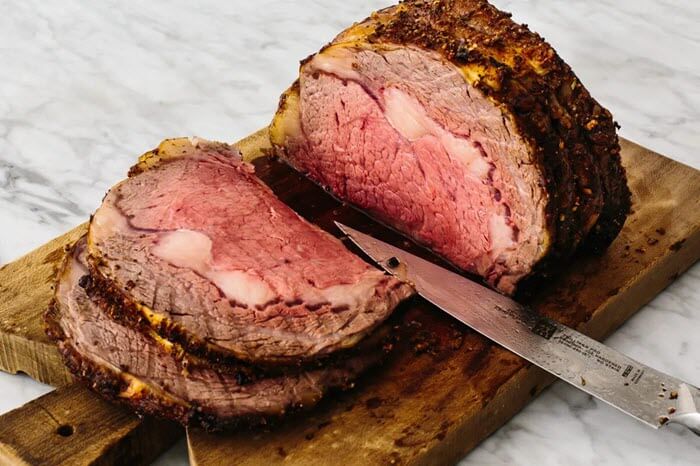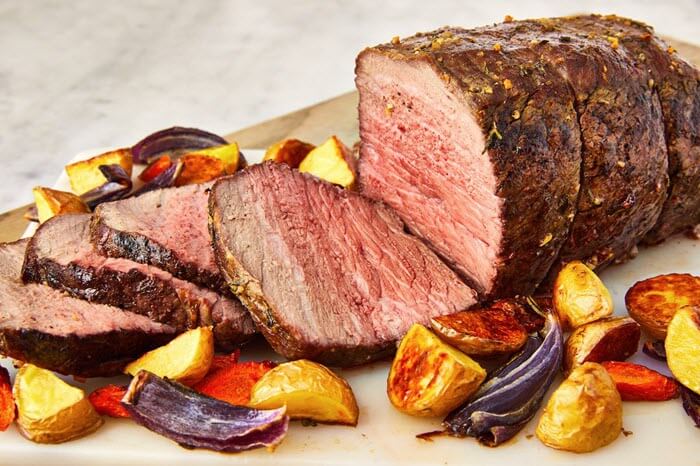Few dishes deliver satisfaction on a special occasion like a beef entree. Meals like prime rib and roast beef appear on menus at weddings, Valentine’s Day, and elegant restaurants worldwide.
But prime rib and roast beef are very different presentations of beef.
Knowing the difference between prime rib and roast beef will help you plan your next special occasion meal.
Table Of Contents
What is Prime Rib?
Prime rib is a section of cow’s ribs known for its tenderness and robust flavor. It is considered one of the “primal cuts” of beef.
According to the USDA [1], primal cuts refer to the main quarters of a butchered cow. The chuck, loin, round, and rib are all primal cuts.
Prime rib is also known as a standing rib roast. While the entire rib section contains ribs six through 12, a prime rib may comprise between two to seven ribs.
Prime rib is the beef equivalent of a rack of lamb. When the rib section is further broken down, prime rib becomes individual ribeye steaks.
What is Roast Beef?
Roast beef is the end product of several different kinds of beef preparations. Making a pot roast or buying sliced sandwich meat at the grocery store are both forms of roast beef.
Roast beef most often comes from the chuck roast portion of the cow. Another primal cut, this meat is known for being tougher, as it is located on the cow’s shoulder area.
As these muscles are used constantly, a chuck roast requires careful preparation to make it tender enough to eat.
Differences in Prime Rib vs. Roast Beef
Prime rib and roast beef represent very different products. These two cuts of beef differ in preparation method, flavor, texture, cost, and versatility.
Differences | Prime Rib | Roast Beef |
Preparation Method | Cooks at around 225 °F | Slow-cooking at 350 to 400 °F |
Flavor | Rich, fatty flavor | Blander flavor |
Texture | Soft and tender | Chewy and relatively stiff |
Cost | More expensive | More affordable |
Preparation Method
Roast Beef
Roast beef requires a slow-cooking method over high heat.
- A chuck roast or similar cut requires at least three hours of cooking between 350 and 400 degrees Fahrenheit.
- Place the chuck roast in a dutch oven with a few cups of water, aromatic herbs, and vegetables like onions and carrots.
Prime Rib
Because prime rib represents a much different section of the cow than roast beef, the cooking method is different.
Both require a long time for the meat to cook. The rule of thumb for prime rib is between 30 – 45 minutes of cooking time per pound.
The biggest departure from roast beef is the cooking temperature. While roast beef requires a high roasting temperature, prime rib cooks at around 225 degrees Fahrenheit.
- A prime rib roast stands on the rib bones to lift the prime rib out of the pan.
- The bones rest on the bottom of the enamel roasting pan or similar heavy-duty dish.
Cooking prime rib this way maintains the tenderness and flavor of beef roasted close to the bone.
Flavor
Prime rib and roast beef vary greatly in terms of flavor.
Roast Beef
Roast beef usually has a blander flavor than prime rib, as many chuck roasts are boneless.
Many embellishments are usually added to help add taste, including assertive flavors like mustard, onions, or horseradish [2] with roast beef.
Prime Rib
Prime rib stands on its own with wonderful beef flavor. Unlike roast beef, prime rib rarely arrives with aggressive add-ons.
Many presentations of prime rib feature only a seasoned exterior crust, adding a peppery flavor to the meat.
This cut of meat relies heavily on the bones it is roasted on for additional dimension. The heavily marbled meat imparts rich, fatty flavor into the prime rib.
Texture
Roast Beef
Chuck roast, the cut of meat forming the cow’s shoulder, provides a large, well-muscled hunk of beef. Slow-cooked, braised chuck roast eventually loosens the well-built muscle fibers to become more tender.
Roast beef always remains chewy and relatively stiff compared to other cuts of beef. Long strands of muscle fiber are present within roast beef.
However, a pot roast will never taste as buttery as the largely-used cow’s rib section.
Prime Rib
Prime rib delivers a soft, tender cut of meat, whether rare or more well done.
An expertly-cooked prime rib may not even need a steak knife to eat, providing a fork-tender dining experience.
Cost
One of the differences between these two cuts of meat is price.
Roast Beef
A chuck roast requires manipulation and a long cooking time, making it more affordable.
Because roast beef can be made from an array of less-desirable cuts, roast beef is much less expensive than prime rib.
Prime Rib
As the name implies, prime rib carries a premium price.
Prime rib requires a distinct portion of meat, cut from some of the most tender parts of the animal. This combination of factors makes prime rib two to three times more expensive per pound than meat used for roast beef.
Roast beef provides a versatile and delicious meal option to satisfy any appetite. Below is one of our favorite roast beef recipes.

Roast Beef with Shallots
Delicious roast beef to make at home.
Ingredients
- 1 bottom round roast (5 lbs)
- 6 tbsp extra-virgin olive oil
- 1/4 c chopped garlic (from 1 head)
- 2 handfuls of sage, oregano, rosemary, or thyme sprigs, or a combination
- Kosher salt and freshly ground pepper
Instructions
1. Season beef with salt and pepper, then wrap with plastic and refrigerate for at least eight hours.
2. After eight to 24 hours elapses, unwrap the beef and let it sit at room temperature for one hour. Preheat the oven to 350 degrees.
3. Heat an oven-safe skillet on medium-high and brown all sides of the beef.
4. Remove beef from the skillet and set aside and discard the leftover oil.
5. Scatter garlic and herbs on the bottom of the skillet and place the beef on top, fat side up. Roast for 45 minutes.
6. After 45 minutes, take out the roast and drizzle it with oil and herbs.
7. Continue roasting until the meat reaches 105 degrees Fahrenheit for rare doneness at its thickest part.
8. Then take out the roast and let it rest for 30 minutes before slicing to serve.
Nutrition Information:
Yield: 10 Serving Size: 1Amount Per Serving: Calories: 132Total Fat: 11gSaturated Fat: 2gTrans Fat: 0gUnsaturated Fat: 8gCholesterol: 7mgSodium: 35mgCarbohydrates: 8gFiber: 5gSugar: 0gProtein: 4g
FAQs About Prime Rib and Roast Beef
Continue reading to learn more about prime rib vs. roast beef.
Does prime rib taste like roast beef?
Prime rib and roast beef taste very different.
Prime rib, like ribeye steak, delivers a tender and buttery flavor. You may see and taste a lot of beef fat clinging to your prime rib. Roast beef offers a chewier texture than prime rib.
Why is prime rib so expensive?
Prime rib represents a premium cut. Because this cut of meat is intentionally selected for a standing rib roast, its exclusivity also drives up the price.
Conclusion
In addition to coming from different parts of the cow, prime rib vs. roast beef differs in cooking preparation, flavor and texture, cost, and versatility.
Enjoy roast beef for a fulfilling Sunday dinner. Select prime rib for your next special occasion.
You May Like



